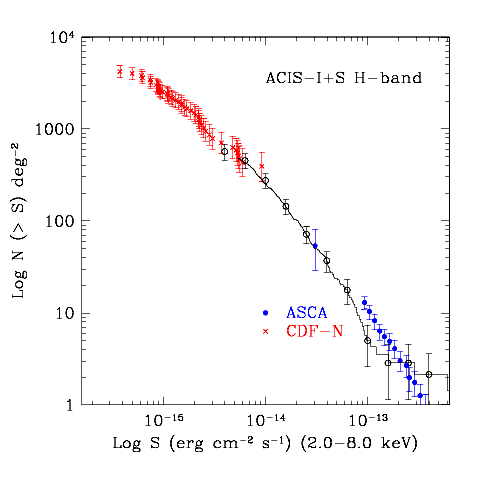 |
| FIGURE 16: LogN-logS in the hard (2-8 keV) band measured in ChaMP ACIS-I fields. Also plotted for comparison are results from the Chandra Deep Field North and ASCA (adapted from Kim et al. 2004). |
The project begins with X-ray image processing, source detection and a photometry pipeline (XPIPE) described in detail in Kim et al. 2004 (ApJS, 150, 19). The first ChaMP X-ray catalog consists of 991 X-ray sources - a bright, near on-axis subsample obtained from an initial sample of 62 observations. The resulting logN-logS relations in soft (0.5-2 keV) and hard (2-8 keV) energy bands (Kim et al. 2004, ApJ, 600, 59; and 2004, ApJS, 150, 19) spans the gap in X-ray flux between previous deep ROSAT/ ASCA surveys and deep Chandra and XMM results (Figure 16) over a large area of sky (about 7 sq deg per Cycle). Contrary to previous reports, we find no significant difference between the logN-logS in 33 fields with known (z > 0.3) clusters, and 29 fields without clusters. Cosmic variance is consistent with a Poisson distribution. Most X-ray hardness ratios are consistent with unabsorbed AGN power-law spectra. Observed hardening is largely confined to the softest energy band (0.3-0.9 keV), suggesting that hardening is most likely due to absorption.
 |
| FIGURE 16: LogN-logS in the hard (2-8 keV) band measured in ChaMP ACIS-I fields. Also plotted for comparison are results from the Chandra Deep Field North and ASCA (adapted from Kim et al. 2004). |
With deep, wide-field optical imaging of ChaMP fields in Sloan g', r', i' filters at NOAO 4 meter telescopes, we have determined optical counterparts to about mag 24.5 to > 70 % of the X-ray sources in our fields of median X-ray depth (~ 3 x 10-15 ergs cm-2 sec-1). Our method and first results for 6 fields are presented in Green et al. 2004 (ApJS, 150, 43). About 40 such fields are now analyzed, with further imaging runs awarded. We also have plans to extend the optically brighter sample by crosscorrelation with the SDSS photometric database.
A primary use for our current deep imaging sample is an optical/X-ray hunt for low LX or high-redshift (0.3 < z < 1) galaxy clusters. We use Voronoi Tesselation and Percolation to find galaxy overdensities in the optical data. These are verified by early-type galaxy red sequence detections in our color-magnitude diagrams. These apparent optical clusters may still represent line-of-sight projections of filaments or other large-scale structures. A study of the fraction and nature of those clusters which are also detected as extended X-ray sources is underway (Barkhouse et al. 2004, in preparation).
With few but notable exceptions, our X-ray spectral fitting reveals that BLAGN are at most lightly absorbed (NH < 1022 cm-2), while many of the NELG have detectably large columns of absorbing gas. An extension to XPIPE for X-ray spectral fitting is complete, and X-ray spectral analysis of a large and uniformly-selected BLAGN sample to z > 2 is extant (Aldcroft et al. 2004, in prep).
There are also stars in ChaMP fields, providing another example of the benefit of investigating all the objects in a sizable area. This segment of Champ is called CHESS (Chandra Extended Stellar Survey). Among projects begun or proposed for the X-ray images, optical images, and optical spectra of the stars is to look at X-ray flux for A stars to investigate the onset of magnetic activity, a search for X-rays in even hotter stars, and an investigation of the luminosity function of M stars. CHESS is one of several ChaMP areas that has benefitted from work by an undergraduate summer student.
Other ChaMP science studies include: VLA follow-up of those ~ 140 ChaMP sources coincident with FIRST/NVSS radio sources; a search for high-redshift X-ray jets (Schwartz et al., 2004, ApJ submitted); Spitzer observations of optically unidentified bright X-ray sources in search of absorbed and/or high-redshift AGN; X-ray timing studies; cross-correlation with other major catalogs including 2MASS and SDSS. Opportunities abound. For more ChaMP information, updates, and results, check http://hea-www.harvard.edu/CHAMP/ or contact the authors. There is also a parallel project, Champlane, concentrating on an X-ray and optical study of Chandra fields in the galactic plane (Josh Grindlay, Lead). More about that one in a future newsletter.
We gratefully acknowledge support for this project from NASA under CXC archival research grants. Optical data for the ChaMP are obtained in part through the National Optical Astronomy Observatory (NOAO), operated by the Association of Universities for Research in Astronomy, Inc. (AURA) under cooperative agreement with the National Science Foundation. A portion of the results presented here made use of the Multiple Mirror Telescope Observatory, a facility operated jointly by the University of Arizona and the Smithsonian Institution.
Paul J. Green, W. A. Barkhouse, R. A. Cameron, D.-W. Kim, J. Silverman, and B. J. Wilkes (SAO), for the ChaMP Collaboration.